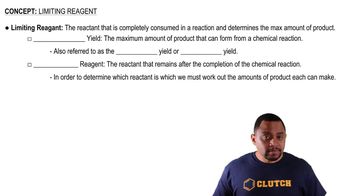Silicon has the diamond structure with a unit cell edge length of 5.43 Å and eight atoms per unit cell. (b) Suppose you dope that 1 cm3 sample of silicon with 1 ppm of phosphorus that will increase the conductivity by a factor of a million. How many milligrams of phosphorus are required?
Ch.12 - Solids and Modern Materials
Chapter 12, Problem 131d
One method to synthesize ionic solids is by the heating of two reactants at high temperatures. Consider the reaction of FeO with TiO2 to form FeTiO3. Determine the amount of each of the two reactants to prepare 2.500 g FeTiO3, assuming the reaction goes to completion. (d) Determine moles and mass (g) of FeO required.
 Verified step by step guidance
Verified step by step guidance1

Verified video answer for a similar problem:
This video solution was recommended by our tutors as helpful for the problem above.
Video duration:
5mWas this helpful?
Key Concepts
Here are the essential concepts you must grasp in order to answer the question correctly.
Stoichiometry
Stoichiometry is the calculation of reactants and products in chemical reactions based on the balanced chemical equation. It allows chemists to determine the proportions of substances involved in a reaction, which is essential for predicting how much of each reactant is needed to produce a desired amount of product.
Recommended video:
Guided course

Stoichiometry Concept
Molar Mass
Molar mass is the mass of one mole of a substance, typically expressed in grams per mole (g/mol). It is crucial for converting between the mass of a substance and the number of moles, enabling the calculation of how much of each reactant is required to achieve a specific mass of product in a chemical reaction.
Recommended video:
Guided course

Molar Mass Concept
Limiting Reactant
The limiting reactant is the substance that is completely consumed first in a chemical reaction, thus determining the maximum amount of product that can be formed. Identifying the limiting reactant is essential for accurate stoichiometric calculations, as it influences the amounts of other reactants needed and the yield of the product.
Recommended video:
Guided course

Limiting Reagent Concept
Related Practice
Textbook Question
Textbook Question
One method to synthesize ionic solids is by the heating of two reactants at high temperatures. Consider the reaction of FeO with TiO2 to form FeTiO3. Determine the amount of each of the two reactants to prepare 2.500 g FeTiO3, assuming the reaction goes to completion. (a) Write a balanced chemical reaction. (c) Determine the moles of FeTiO3.
Textbook Question
One method to synthesize ionic solids is by the heating of two reactants at high temperatures. Consider the reaction of FeO with TiO2 to form FeTiO3. Determine the amount of each of the two reactants to prepare 2.500 g FeTiO3, assuming the reaction goes to completion. (b) Calculate the formula weight of FeTiO3.
